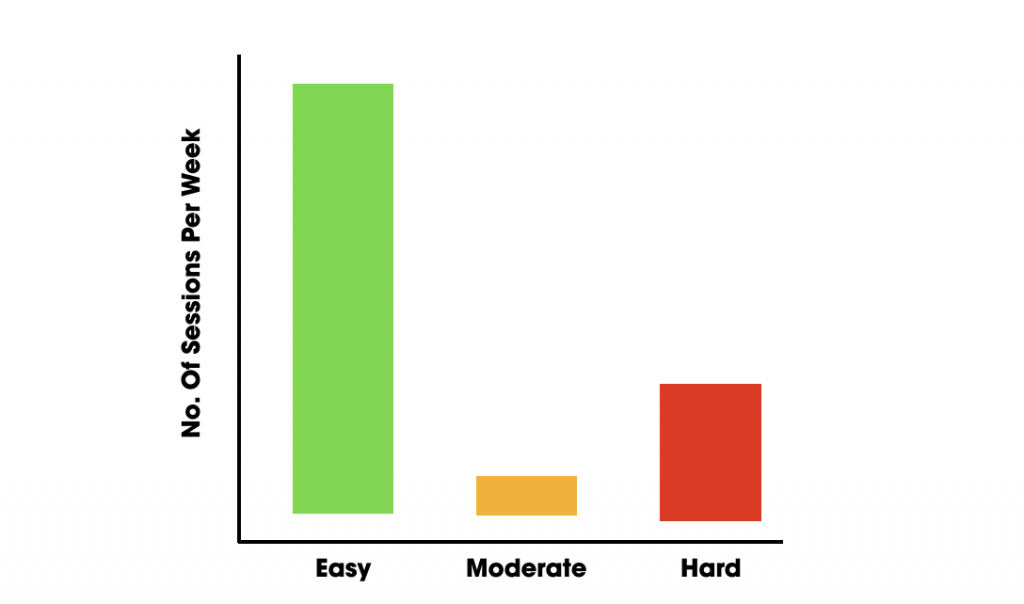What is 80/20 training?
A very common training approach among endurance athletes is so-called ‘80/20’ or ‘polarised’ training.
The basic premise of this training is that the majority of training sessions (around 80% or 4/5 sessions) are done at a low intensity.
The remaining 20% are mainly done at a high intensity, above something known as your ‘threshold’ (we’ll explain this concept in a later article, but you can consider this to be roughly your 10km pace). Your high-intensity sessions will usually be structured interval sessions, but can also include races or hard group training sessions, for example.
The natural tendency of most runners is to run at more of a medium intensity that sits between the low and high intensity zones, and feels hard but sustainable. This intuitively feels like you’re getting a good workout, because you’re pushing pretty hard for the duration of your run. This medium intensity is also sometimes known as ‘tempo’ or ‘threshold’.
However, with the 80/20 approach, you’ll want to knock the intensity down a notch or two for most of your runs, so that the effort feels relatively easy, and importantly, so that your breathing rate is ‘conversational’ – i.e. you have no trouble talking in full sentences.
This might feel quite unnatural initially, and it might even mean you need to slow right down to a walk on some hills. But you’ll soon get used to it, and training in this way can really pay dividends.

Why running slower makes you faster
It may sound counter-intuitive, but running slower and adopting an 80/20 training approach has been shown in many studies to make you faster! This is also a training approach used by a great number of top-level endurance athletes.
Some of the reasons the 80/20 approach works include:
- Running slow helps develop your ability to use fats for fuel. In fact, slow running is the best intensity to develop this ability. Your ability to use fats for fuel helps you run for longer, and at a higher intensity without hitting fatigue.
- By doing more of your training at a low intensity, you should be feeling quite fresh for your higher-intensity sessions, which means you can perform these sessions better.
- Related to the above, training mostly at a low intensity, allows you to diversify your training, so that you can work on different aspects of your fitness. Conversely, by training exclusively at a middle-intensity, your fitness can quickly stagnate because all training sessions look the same and you never quite have enough energy to push really hard and hit the intensities necessary to improve higher-end abilities.
- Training at a lower intensity also helps avoid injury, overtraining and illness, which can interrupt your training. One of the most important determinants of fitness progression is training consistency!
- Finally, if you have the time for it, training mostly at a lower intensity will allow you to run more each week without getting too fatigued.
Should all middle intensity running be avoided?
I’m not actually a big fan of the term ‘80/20’ training, because the name tends to suggest that all training should either be high or low intensity, with no middle intensity training included at all.
However, when we look at the training studies and the practices of top athletes, we can see they do still include some middle-intensity training, but in relatively small doses.
In particular, they often include some middle-intensity training within their long runs, which can be a good strategy to help improve your endurance.
Middle-intensity running can also be helpful if you’re looking to get more familiar with running at race-pace and developing your time to exhaustion at this intensity.
The key to 80/20 training is that the middle intensity should be used quite sparingly, and low-intensity running makes up the bulk of your sessions.
As an example, if you tend to run 5-hours per week, then you wouldn’t want to spent more than 20-60 minutes running at a middle intensity, if you’re trying to implement the 80/20 principle.
What if I’m time-crunched?
You might be concerned that if you slow down your training sessions, you’ll lose fitness, particularly if you don’t have time to increase your overall weekly training hours.
However, studies have shown that an 80/20 approach works well for both time-crunched and time-rich endurance athletes.
Time-crunched runners tend to have hectic work and family lives, so an 80/20 approach can work well in supporting recovery between harder training sessions, and maintaining training consistency, as well as working on your all-important fat oxidation abilities!
Key Tips
- Aim for 1-2 higher-intensity sessions each week. This could be structured intervals with the club, a hard group run, a Strava segment-bagging session, or a race/park run.
- Keep all other sessions to a low intensity, where you can easily hold a conversation. As a rough rule of thumb, you should be running around 2mins/mile slower than your 10k race pace. So if you can run 10km at 8min/mile, then you should be doing your easy runs at 10min/mile or slower (bearing in mind hills might slow this pace down even more).
- Aim for one longer run each week that stretches your endurance abilities. This should be done slow (optionally including a little bit of middle intensity running once you become fitter).
- With 80/20 running, it’s often said you need to ‘check your ego at the door’. Try not to worry what your pace looks like on Strava, or whether you’re being overtaken on a hill. Instead, try to remember the goal of your session and have confidence that you’re doing something purposeful and constructive.
Written by Dr Emma Wilkins (physiology consultant and coach at High North Running)
